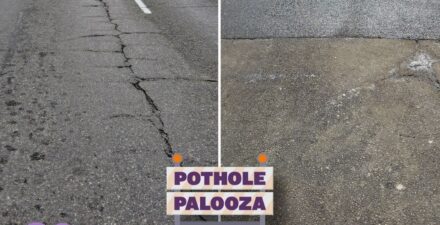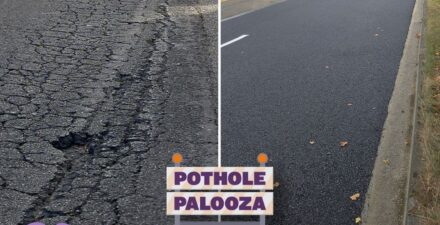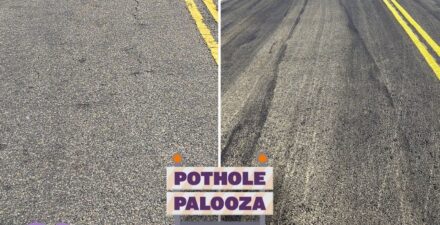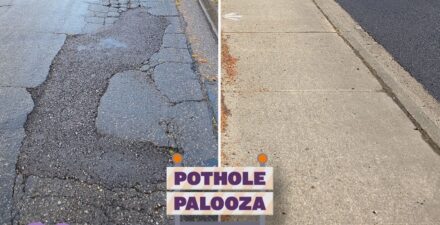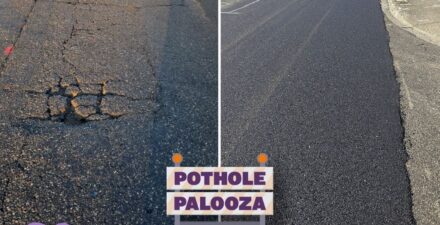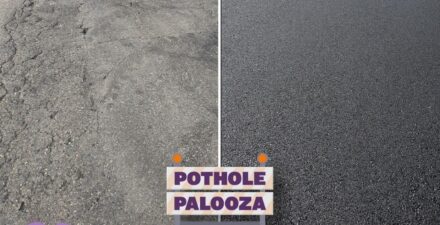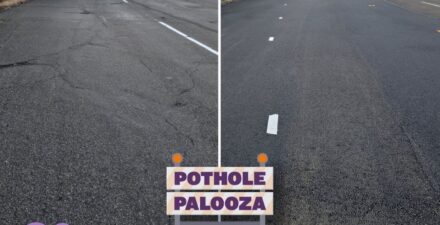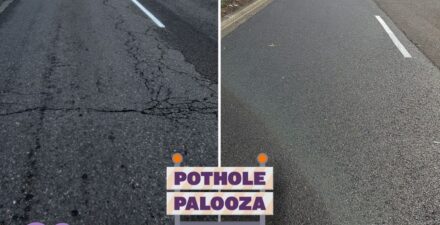
Pothole Palooza
Pothole Palooza, Featuring Phil the Pothole
From September 30 through October 13, 2025, the City’s Street Operations Division were out for Pothole Palooza, a campaign featuring Phil the Pothole.
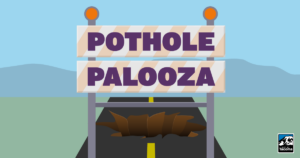
Crews focused on the maintenance and preservation of arterial roadways, which would have a large impact on the city. Projects took place in each of the five council districts. During Pothole Palooza, crews were out at 10 locations around the city. Street Operations staff planned this work before starting Tacoma Streets Initiative programs, which happened during the summer.
Repairing potholes on city streets happens all year round. The community is asked to report potholes by contacting Tacoma FIRST 311 by dialing 311 within Tacoma city limits or (253) 591-5000 from anywhere else, or by visiting tacoma.gov/311.
Report a Pothole
Street Operations Main Office
2324 South C Street
Tacoma, WA 98402
Map
Contact Asphalt Plant
3010 Center Street
Tacoma, WA 98409
Map
Pothole Palooza 2025
Where Did the Work Take Place?
The City’s Street Operations Division worked at the following locations during the week of September 30 – October 13, 2025, for Pothole Palooza.
| Day/Date | Project Area | Location of Work | Council District |
|---|---|---|---|
| Tuesday, September 30, 2025 | 6th Avenue/6000 Block to South Pearl Street | Eastbound Lane Repairs | District 1 |
| Wednesday, October 1, 2025 | South 19th Street/Summit Avenue to South Pearl Street | Westbound Curb Lane Replacement | District 1 |
| Thursday, October 2, 2025 | South Jefferson Street/Tacoma Ave South to South 27th Street | Northbound Curb Lane Replacement | District 2 |
| Friday, October 3, 2025 | Norpoint Way NE/ Point Woodworth Dr NE (110 Block) to 1400' North | Northbound Curb Lane Replacement | District 2 |
| Monday, October 6, 2025 | South Pine Street/4500 Block to 4302 South Pine Street | Northbound Curb Lane Replacement | District 3 |
| Tuesday, October 7, 2025 | South 38th Street/South Cushman Avenue to South Alaska Street | Westbound Curb Lane Replacement | District 4 |
| Wednesday, October 8, 2025 | East McKinley Way/E D Street to E G Street | North and South Drive Lane Replacements | District 4 |
| Thursday, October 9, 2025 | South 74th Street/South Wapato Street to South Oakes Street | Westbound Curb Lane Replacement | District 5 |
| Friday, October 10, 2025 | East 84th Street/E D Street to E G Street | Eastbound Curb Lane Replacements | District 5 |
| Monday, October 13, 2025 | Sprague Ave State Route Hwy 16 Exit/2300 Block to South 19th Street | Northbound Curb Lane Replacement | District 3 |
How a Pothole is Formed
Pothole FAQs
-
-
2.25 lane miles of arterial roadways repaired
-
15,870 square yards of roadway removed and replaced in just 10 days — equivalent to repairing or preventing 8,927 potholes on Tacoma’s busiest streets
-
3,274 tons of asphalt placed — with 2,046 tons supplied by contractors and 1,228 tons produced at the City’s Asphalt Plant
-
3 traffic signals upgraded with new cameras to improve signal timing, enhance detection for bicyclists and motorcyclists, and boost safety
-
8,713 linear feet of striping and 2 pavement legends refreshed by City crews
-
1.6% under budget — total project cost of $677,170 across 10 projects citywide, completed in all five Council districts (original estimate: $688,000)
-
-
During the weeks of Pothole Palooza, crews were out at 10 locations around the city where they repaired and/or prevented an estimated 5,369 potholes from forming in 2024 and 8,927 potholes from forming in 2025.
How Was the Estimated Number of Potholes Repaired/Prevented Calculated:
A typical permanent pothole repair is 4 feet wide x 4 feet long or 16 Square Feet.
For Pothole Palooza, crews repaired 9,545 SY of pavement combined at all 10 locations. To calculate potholes, you must first convert the number of square yards completed to square feet completed to the number of potholes repaired/prevented.
The formula is 9,545 SY x 9 SF/1 SY x 1 SF/16 SF = “repaired and/or prevented 5,369 potholes from forming”
SY = Square Yards
SF = Square Feet -
Street Operations has assessed arterial routes throughout the city using pavement management data, focusing on projects in each of the 5 Council Districts, assessing roadway conditions, and weighing that with the City’s Equity Index.
-
Arterials are larger roadways that deliver traffic between collector roads and freeways. These roadways carry most of the city’s heavy traffic and transit systems. The best way to identify them is that there is center yellow or white lane striping.
-
The City understands and acknowledges the numerous requests for street maintenance on certain arterials and streets in Tacoma. Arterial roads need extensive repair, more than current resources allow.
Due to the short duration of this event combined with limited resources such as staffing, funds, equipment, and logistical challenges, Street Operations can only focus on a certain number of locations during the duration of this event.
Street Operations will continue to address additional maintenance needs throughout the rest of the year as part of its normal business practice.
These locations were prioritized based on the frequency of past reports and requests, the City’s Equity Index, and providing service in each of the 5 council districts.
-
Road closures and detours will be in place from 7 a.m. to 7 p.m. Roadways will be reopened once scheduled work is completed.
Each location is different and will have its own unique traffic management needs.
Traffic control, including lane closures and detours, will be set up to safely move vehicles and pedestrians through or around the work zones. In some cases, traffic may be diverted or temporarily halted to ensure the safety of both workers and the traveling public.
Traffic cones, signs, and flaggers may be present to guide vehicles safely around the work area. When roadways need to be closed, detours will be used to direct the traveling public. Notice boards will be placed at each location at least a week before the start of the work.
-
Overall, the public will witness a coordinated effort by City crews to repair defective pavement and improve the condition of the roadways.
Work Crew: Street Operations Staff will be mobilizing for these projects each day, setting up traffic control, preparing the site, removing the asphalt, and paving the same day. It is referred to as “grind and pave.”
Construction Vehicles: Crews will be using standard construction equipment geared towards asphalt paving, such as dump trucks, self-loading milling machines, skid steer loaders, asphalt paving machines, and rollers.
Traffic Control: In some cases, traffic may be diverted or temporarily halted to ensure the safety of both workers and the traveling public. Traffic cones, signs, and flaggers may be present to guide vehicles safely around the work area. When roadways need to be closed, detours will be used to direct the traveling public.
Materials: Crews will either remove and dispose of the asphalt grindings at a local disposal site, or if they are acceptable, they may be used to produce future asphalt for future projects.Crews will also purchase asphalt mix from a local vendor. All asphalt mixes will meet the City of Tacoma and State of Washington material requirements.
Process: Crews will remove the distressed asphalt using their self-loading milling machine and place and compact new asphalt. If lane striping is removed, crews will place temporary striping, and then once the asphalt cools, our striping crew will return to install the permanent lane striping.
Safety Measures: The crew will take safety precautions to minimize risks during the repair process. This will include public notice of the coming project, wearing personal protective equipment to be visible to the traveling public, traffic control, and following established safety protocols.
-
The final program cost came in at $677,170 for 10 projects citywide, with work completed in all five council districts. The initial estimate was $688,000, bringing the program in 1.6% under budget.
